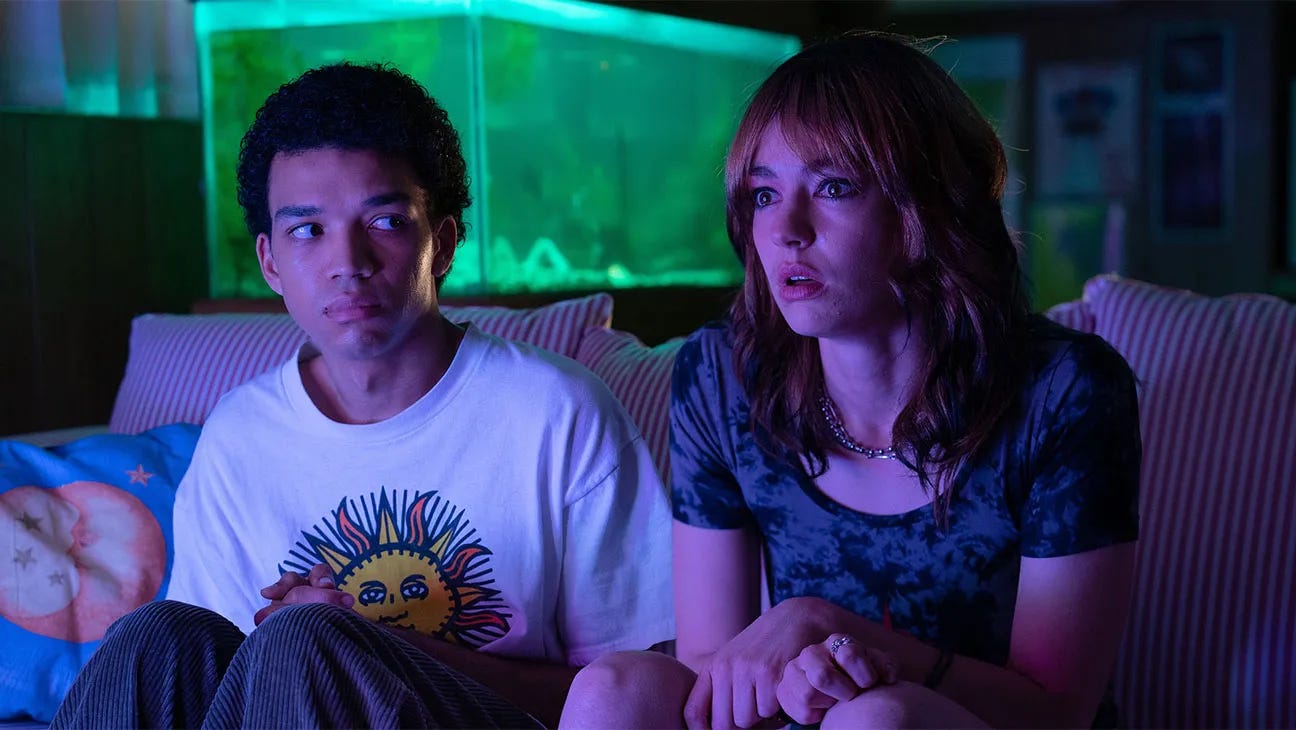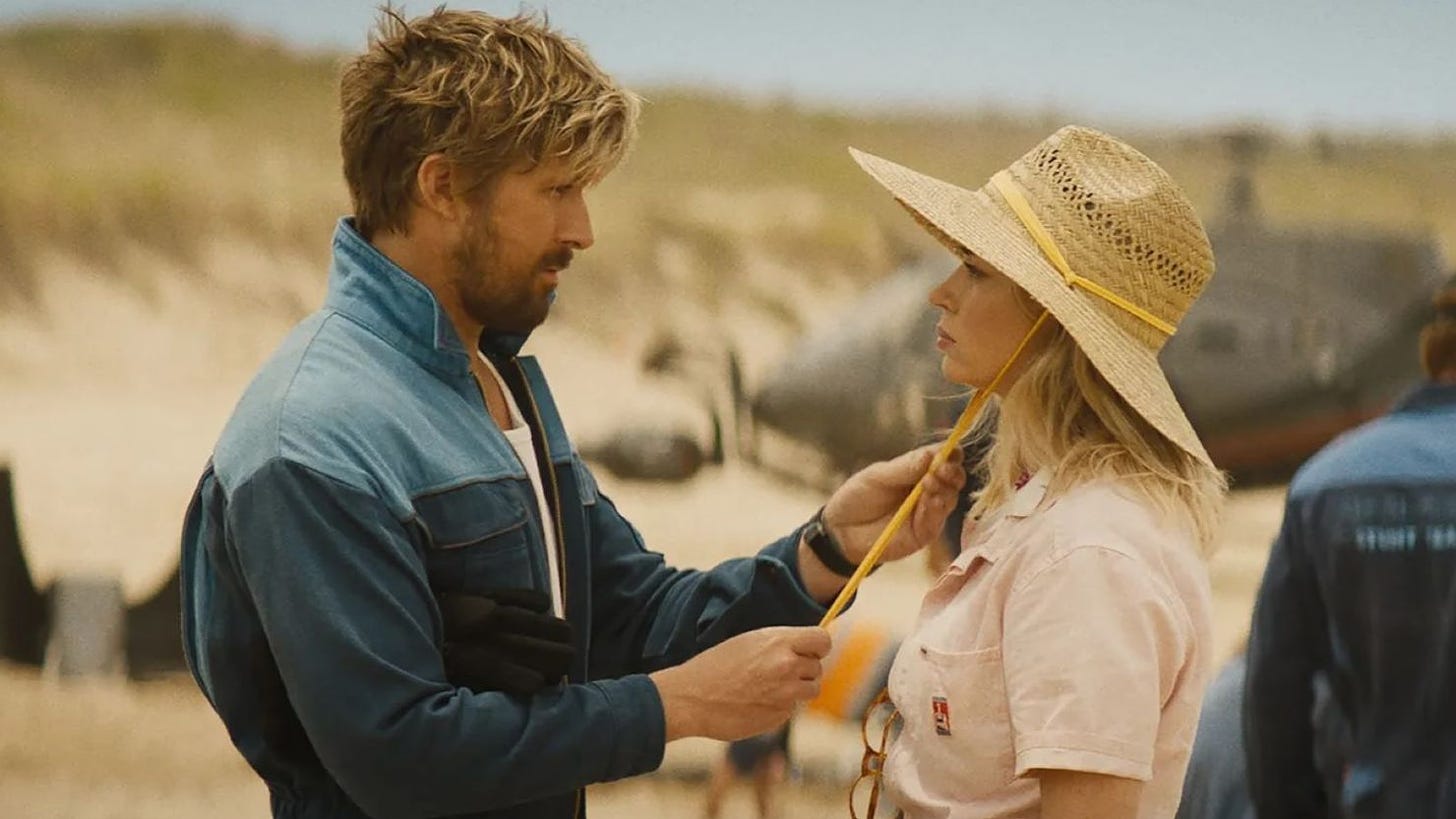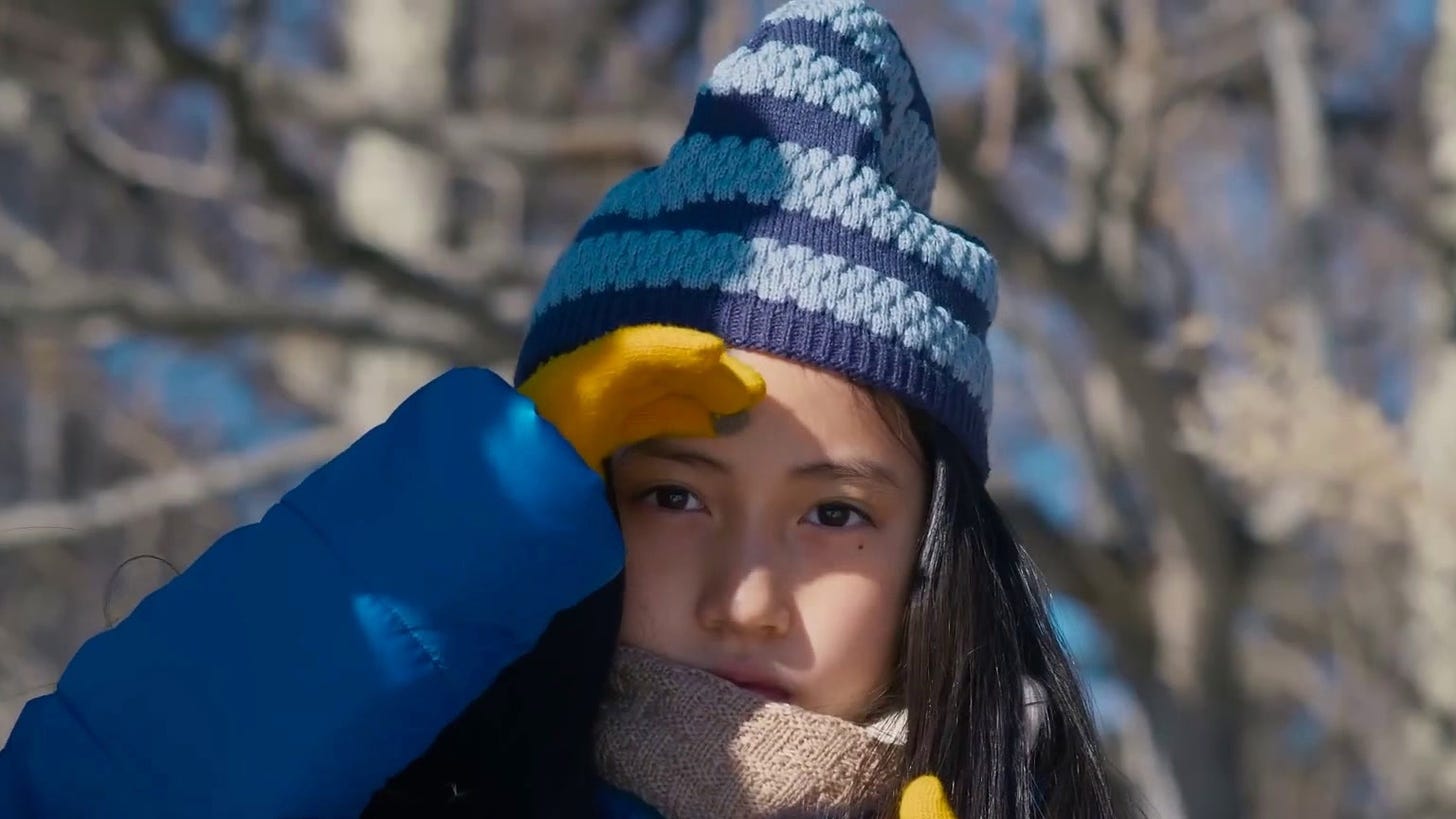In Review: 'I Saw the TV Glow,' 'Fall Guy,' 'Evil Does Not Exist'
This week brings exciting new work from the directors of 'We're All Going to the World's Fair' and 'Drive My Car," and a mainstream homage to stunt work.
I Saw the TV Glow
Dir. Jane Schoenbrun
100 min.
When Owen (played as a boy by Ian Foreman and as a teen and adult by Justice Smith) first encounters The Pink Opaque, it looks like a world he’ll never be able to enter. A supernatural drama about two girls who share a psychic bond and fight a series of bizarre threats—think Buffy the Vampire Slayer by way of Are You Afraid of the Dark? and The Adventures of Pete and Pete—it airs after his bedtime on Saturday nights. But there are other barriers to entry, too. As his mother votes in the 1996 presidential election, young Owen encounters an older teen named Maddy (Brigette Lundy-Paine) reading a thick Pink Opaque episode guide detailing the series’ complicated lore. Maddy’s not that friendly and talks about the show in terms more forbidding than inviting. But, perhaps sensing a kindred spirit, she eventually opens up to the kid, welcoming Owen when he begins sneaking out of the house under the guise of a slumber party at the home of another’s friends and letting him sit, transported, as each new episode unfolds. To them, The Pink Opaque plays like a shared secret to those who, like the Pink Opaque girls as they talk to each other across the distance, can tune into the right frequency.
Or at least that’s how Owen remembers it years later. But memory’s a slippery thing in I Saw the TV Glow, writer and director Jane Schoenbrun’s follow-up to their 2022 debut We’re All Going to the World’s Fair. Like that film, I Saw the TV Glow is deeply invested in the relationship between media and identity and what in teens’ lives rushes in to fill the voids created by loneliness and confusion. For Owen and Maddy, The Pink Opaque becomes not so much a form of escapism as an alternate world, allowing them to step away from the one in which Owen’s a bit too soft to fit in with the other boys and Maddy gets abandoned by girlfriends who turn on her to fit in with their straight friends. Its heroines’ triumphs are their own. Their antagonists are villains whose silly appearances belie their symbolic weight. At times, it’s almost realer than the real world. Or maybe it is the real world?
That bare description might suggest a simple twist at the heart of I Saw the TV Glow, but that’s not really what Schoenbrun’s up to here. There’s nothing clean or schematic about I Saw the TV Glow, which not only freely blurs the line between what’s real and what’s imagined but sometimes inverts them. Even when Owen recounts his story directly to viewers, it’s not entirely clear he understands what’s happened in the past, or what’s happening still. What is clear is The Pink Opaque has revealed something about himself that he can’t quite face. I Saw the TV Glow never explicitly addresses the issues of sexual and gender identity raised by the story but it doesn’t really have to. Here television works less as a window to another world than a mirror that shows those watching parts of themselves they couldn’t otherwise see.
That’s as true of those who want to be shown it as those who don’t and the air of unease Schoenbrun creates stems as much from Owen’s discomfort as the film’s unsettling mood—often created, as promised by the title, by glowing televisions—and fluid sense of reality. In fact, atmosphere and emotion come to feel entwined, as time speeds up and slows down for Owen and even The Pink Opaque starts to feel less like an anchor in a roiling world than another mystery: maybe a threat, maybe a treasure, maybe a way out, maybe just another trap, or maybe nothing more than a TV show, if there really is any such thing. —Keith Phipps
I Saw the TV Glow arrives in select theaters tomorrow before expanding.
The Fall Guy
Dir. David Leitch
126 min.
Director David Leitch was a stuntman and second-unit director for decades before teaming up with Chad Stahelski, a filmmaker with a similar résumé, on John Wick, the franchise they started together before peeling off on their own. Neither has rejected CGI in the big-budget productions they’ve overseen—Leitch did Atomic Blonde, Deadpool 2, and Bullet Train; Stahelski continued the John Wick series to four movies and counting—but they have proven, beyond a reasonable doubt, that audiences crave the derring-do of real humans flipping cars, smashing through breakaway windows, and otherwise risking their necks for a few seconds of entertainment. It seemed inevitable that one of them would make a feature-length homage to stunt players, and so here’s Leitch’s The Fall Guy, an action-comedy that doubles as a meta-critique of an industry that strives to keep these invisible craftspeople invisible.
Now if only The Fall Guy were as dedicated to the craft of screenwriting. Written by Drew Pearce—who penned Iron Man 3 and Leitch’s Fast & Furious Presents: Hobbs & Shaw, as well as writing and directing Hotel Artemis—the film attempts something close to the blockbuster self-awareness of Tropic Thunder or a Shane Black project, but only gives you the suggestive bouquet of it rather than much of the real thing. That doesn’t prove ruinous to a film where other talented professionals like Leitch and his stars, Ryan Gosling and Emily Blunt, fill in the gaps with charm and bravado, but it’s frustrating to see them laboring like Andrew McCarthy and Jonathan Silverman to prop up a screenplay that can’t stand on its own feet.
Drawing loose inspiration from the ‘80s Lee Majors TV series of the same name, The Fall Guy opens with stuntman Colt Seavers (Gosling) doing another take as a double for Tom Ryder (Aaron Taylor-Johnson), the type of mega-star who likes to brag in the press about doing his own stunts. (Tom Cruise’s ears will be burning over several lines in this movie, like when a director talks about Ryder “running weird.”) After flirting with his girlfriend Jody Moreno (Emily Blunt), a camera operator with ambitions to direct, Colt gets so horribly injured in a stunt that he leaves his career, and Jody, behind. Eighteen months later, Ryder’s producer (Ted Lasso’s Hannah Waddingham) phones him from Australia, where Jody is directing her first feature and has specifically requested his return as Ryder’s double. This is a lie.
Once the film shifts to Australia, a jet-lagged Colt hustles between dangerous stunts on Metalstorm, which looks like a sci-fi/action cross between Dune and Mad Max: Fury Road, and real-life adventure on the streets of Sydney, where he’s been asked to track down the troublesome, hard-partying Ryder. Gosling’s affability in the midst of all this chaos keeps The Fall Guy light and entertaining, even when Leitch’s aggressive stunt showcase begins to tip into an exhausting grind along the lines of his Bullet Train. That the movie-within-the-movie looks awful does no favors to Blunt, who’s supposed to be making a personal dream project, but she and Gosling have a dopey chemistry together that make the rom-com angle look effortless. They’re expert salespeople in need of a better product. — Scott Tobias
The Fall Guy opens in theaters everywhere tonight.
Evil Does Not Exist
Dir. Ryusuke Hamaguchi
108 min.
What happens at the end of Evil Does Not Exist, Ryusuke Hamaguchi’s follow-up to the extraordinary one-two of Drive My Car and Wheel of Fortune and Fantasy, is the stuff of dense Reddit threads and coffeeshop speculation. Just describing the action itself is a perceptual challenge, even before unpacking why (and when) the characters behave as they do and how it might tie into both the drama leading up to it and a title that itself is a conundrum. Yet the 90 minutes or so before the ending are remarkably straightforward, at least narratively speaking, which makes Hamaguchi’s gearshift conclusion all the more audacious and thrilling. Thinking about the relationship between the disparate pieces of Evil Does Not Exist complicates an eco-drama that, by description, could not be clearer in its stakes. The film grows into an enigma.
Set in the village of Mizubiki, a gorgeous idyll carved into a forest with a natural spring and a diverse ecosystem, the film initially stays close to Takumi (Hitoshi Omika), a taciturn widower who looks after his daughter Hana (Rio Nishikawa) and acts as an odd-jobs man for the locals. Like many other Mizubiki residents, Takumi attends a briefing about a new “glamping” development that’s being built in the area, which represents an environmental threat as currently devised. The two PR people running the meeting, Takahashi (Ryuji Kosaka) and Mayuzumi (Ayaka Shibutani), are surprised and humbled by how much Takumi and the villagers know about issues like the size and location of the septic tank or the threat of unsupervised visitors triggering wildfires. Takahashi and Mayuzumi have no answers, and Hamaguchi then shifts perspective to them for a while.
From the development company’s end, the meeting isn’t about coming up with solutions to serious problems, but leveraging power over Mizubizi residents who have no ability to squelch the deal and might be mollified by minor concessions. To that end, the PR reps’ efforts to recruit Takumi as an expert advisor could give the project legitimacy, though Takahashi and Mayuzumi are so humbled by their experience that they start behaving like Peter Riegert in Local Hero. There are several clues in the early parts of Evil Does Not Exist that hint at Hamaguchi’s intentions later on—a line about what happens upstream always has an effect downstream is a key one—but he trusts his audience to sort through those connections on their own. What seems like a downshift in ambition after the enveloping sprawl of Drive My Car turns out, in fact, to be a leap into new terrain, with a seductive uncanniness enforced by the unconventional tracking shots and camera angle, and Eiko Ishibashi’s lush, beautiful score. Hamaguchi sets up a simple premise that slips elegantly through your grasp. — Scott Tobias
Evil Does Not Exit opens this weekend in limited release.











I hope other people dig it, but I went to an early screening screening of THE FALL GUY last night and it became one of the few movies I've walked out of. I'm sure my initial letterboxd review was unfair to a cast trying its hardest* but the whole thing felt lifeless and rote for something with a nine-figure budget and a cast full of charming ringers. I'll give it another chance sometime.
*-"Somehow, Emily Blunt was funnier in Oppenheimer."
I can't be the only person who remembers METALSTORM: THE DESTRUCTION OF JARED-SYN, right? Is this what THE FALL GUY is tracking?